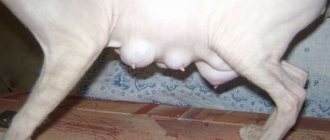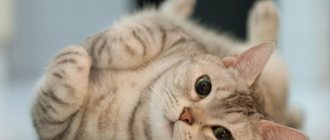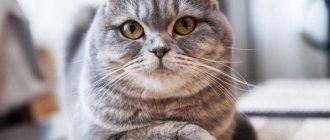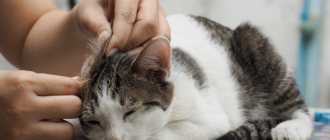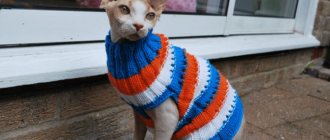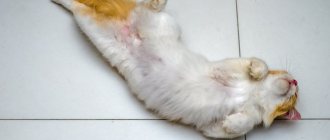10322Administration
A cat in the house means not only happy moments of playing with a pet, but also caring for natural instincts, which will soon wake up and loudly declare themselves. Many owners resort to sterilization of pets, helping to neutralize instincts and at the same time preserve the health of the animal.
The operation is simple, and the recovery period is quick, in most cases without complications. But if a lump on your cat’s stomach begins to cause suspicion after sterilization, do not delay your visit to the veterinarian. What this swelling could be - read below.
Types of sterilization, the appearance of a lump on the stomach
Sterilization is a surgical operation that is aimed at extinction, preventing sexual estrus and reproductive functions in females. The operation is performed in a clinic or at home under general or combined anesthesia.
If the owners of furry pets follow all the instructions and recommendations of the veterinarian and provide proper care, the rehabilitation period takes on average about 10-14 days, after which the cat recovers and gradually returns to its normal life.
- Sterilization of females is a cavity operation (classical method). The incision is made along the white line of the abdomen.
- Laparoscopy is also practiced, in which special equipment (laparoscope) and a lateral incision are used. The latter option involves dissecting the tissue from the side without damaging the muscle fibers (the muscles move apart along the path of the scalpel).
Important! Laparoscopy is the most gentle technique; after surgery, complications rarely arise due to the absence of external sutures.
The most traumatic surgical intervention can be called the classical method of sterilization. After such an operation, the cat needs special care and attention. In addition, postoperative complications cannot be excluded.
After abdominal surgery, a cat may develop a lump or lump-like growth on its abdomen. The swelling (soft, hard) is localized in the area of tissue dissection on the abdomen under the skin or under the suture. This can be caused not only by surgery, but also by diseases of the internal organs that worsen after the procedure.
Let's look at what this means and whether you should worry about it.
The main reason for the appearance of a lump
The main cause of complications after sterilization is non-compliance with the rules of postoperative care for the cat. However, certain rules must be followed before preparing a cat for sterilization. The pet must stop eating 12 - 14 hours before the operation, and an hour before sterilization the cat should not be allowed to drink, since the animal’s intestines and bladder must be empty.
In addition, place the cat on the floor on a warm bedding, as the anesthetized pet will try to crawl and may fall if placed on an elevated surface, and the bedding should be warm due to the reduced body temperature of the cat after sterilization. Rubbing the paws and ears will help restore your cat's blood circulation.
Reasons for the appearance of a hard lump under the seam after sterilization
Any impact on the body can have various consequences. The reasons for the appearance of hard, soft swellings on the peritoneum in the area of the suture or under it are of a different nature, and not all lumps formed after sterilization pose a danger to the health of the operated cat.
As a rule, after sterilization, if the operation is performed according to all the rules, there should be no formations or compactions. A slight swelling is acceptable only on the first day after the classical sterilization method.
If you notice that after sterilization your cat has a hard swelling or lump on its abdomen, a similar phenomenon may be caused by:
- Infection in wounds. If a cat licks or chews the stitches, pathogenic microorganisms penetrate into the wounds, which provokes the development of acute inflammation. Bacteria slow down tissue regeneration and provoke other serious complications (cellulitis, abscesses, fever).
- Hernia prolapse . Occurs due to divergence of internal (subcutaneous) surgical sutures, which leads to prolapse and protrusion of internal organs into the hernial sac (peritoneal opening). A similar problem can arise due to the incompetence of the veterinarian or if low-quality suture material is used. A postoperative hernia is localized in the suture area and if there is no pinching, it does not cause pain. The seal is movable, disappears after light pressure, the lump is soft to the touch. Its size may change, for example, after eating. In the case of tissue inflammation, strangulation of the hernia may occur, which requires immediate treatment.
- Postoperative swelling. The appearance of a lump on the abdomen is the body’s protective reaction to tissue damage. After the operation, the body's defenses are activated, so a swelling forms in the area of the suture or under it. The seam swells, turns red, and the tissues look swollen. This condition is not a pathology. The swelling will go away completely within 10-17 days.
Suture in cats after sterilization
As mentioned earlier, where the suture will be located after spaying a cat depends on the method and type of surgery to remove reproductive organs in females.
An important point is proper treatment and care of the suture after sterilization. Until the veterinarian allows the sutures to be removed, it is necessary to carry out daily treatment with special antiseptic agents that do not contain alcohol (to avoid skin burns).
The suture heals after sterilization in a cat, depending on the incision and the method of operation performed. In the vast majority of cases, sutures are removed within 7-10 days. Sutures not removed in time begin to grow into the skin on the 12th day.
The seam after sterilization of the cat should look neat, without severe swelling and strong changes in the color of the skin. Stitches are applied during sterilization in two main ways:
- paperclip;
- continuous.
The first type of seam looks like several threads tied into knots at equal intervals. A continuous suture has a beginning and runs through the entire wound, being fixed at the other end.
In veterinary practice, the staple suture is increasingly used. Since when exudate occurs under the skin in the area where suture material is applied, several threads can be removed without unraveling the remaining edges of the wound, which cannot be done with a continuous suture.
When carrying out sterilization using a technique through a side incision, the seam will not be large (no more than 1 cm) and will be located on the side and not in the middle of the abdomen. A suture on the side does not necessarily require wearing a postoperative bandage and caring for it is much easier.
Particular attention should be paid to absorbable sutures, as they are gaining great popularity among veterinarians.
This is due to the fact that when applying a cosmetic suture after sterilizing a cat, careful postoperative care of the sutures is not required.
The risk of postoperative complications is minimized. In addition, self-dissolving sutures in a cat after sterilization are much more convenient for both the owner and the pet itself. There is no need to urgently go to the veterinary clinic, exposing the cat to further stress, to remove post-operative sutures.
The main advantages of an internal suture compared to a cutaneous suture are:
- rapid healing of the wound surface, which is associated with the preservation of trophism of tissue structures;
- the seam does not compress the outer layers of the skin, so damage is minimal;
- absence of postoperative blankets;
- lack of suture removal procedure;
- processing the seam after sterilizing a cat does not require increased attention or special skills;
- preventing the possibility of the seam coming apart as a result of licking by the pet;
- absence of a mark on the skin 2.5 months after the procedure to remove the reproductive organs of a cat.
It is worth remembering that applying a cosmetic internal suture is not always possible for a number of medical reasons. That is why external seams are more often used, requiring further proper care.
The veterinarian who performed the manipulation should tell you how and what to use to treat the cat’s sutures after sterilization. After all, only the surgeon who performed the operation will be able to accurately indicate possible defects and complications during the recovery period.
Before starting to treat the seam, you must give your pet an anesthetic and wait at least 60 minutes. After anesthesia, it is necessary to clean the wound surface from villi, dried blood or ichor using a cotton pad previously soaked in a chlorhexidine solution. It is important to remember that the treatment of the seam itself should be done no earlier than 2 days after sterilization. After cleaning, an antibiotic ointment is applied to the wound, lubricating all folds (this is necessary to prevent pathogenic bacterial microflora from entering and further multiplying into the wound).
If the animal's operation was performed using a side incision, then caring for the wound is even easier. The side seam is treated with special means - Aluminum spray or Chemi spray. Treatment is carried out once a day or once every 2-3 days until the wound is completely healed.
Preventing the formation of lumps under the skin
To avoid the appearance of swelling under the skin, lumps on the abdomen, it is very important to provide proper care, especially in the first week after surgery. For the first 24 hours, do not leave the cat unattended; carefully observe the behavior and condition of the animal. Be sure to ask your veterinarian how to properly care for your cat so that the rehabilitation period passes as quickly as possible.
To avoid wound infection, put on a protective blanket or collar as soon as your cat recovers from the anesthesia. Protective accessories can be made independently or purchased at a clinic or veterinary pharmacy. It is very important that pathogenic flora does not enter the wound and acute inflammation does not develop.
Advice! To treat the seam, use bactericidal, anti-inflammatory lotions, ointments, gels, antiseptic solutions, and disinfectant wipes. Your veterinarian will tell you what products to use.
Make sure that for the first two days the cat does not jump from a height or show excessive activity. Coming off of anesthesia, reflexes are dulled, the body is weakened, and behavior is unpredictable. Therefore, do not leave your pet uncontrolled.
As soon as your cat shows interest in food, feed her small portions. Food should be nutritious and easily digestible. You can give special foods intended for feeding during the postoperative period or formulations for sterilized, neutered animals.
Proper prevention and systematic proper care will help the cat return to normal faster after sterilization. If there are no complications and you follow all the veterinarian’s recommendations, the rehabilitation period will take no more than five weeks.
Preventive measures
To prevent a cat from growing a lump on its stomach after sterilization, it is important to follow simple rules for caring for your pet. Be sure to use alcohol wipes for disinfection, bactericidal ointment and lotion when treating the seam. As soon as the cat begins to recover from anesthesia after the operation, it is necessary to put a blanket on it and strictly ensure that the animal does not try to get rid of the “outfit” and expose the seam.
Provide your pet with clean water and place the bowl next to the bed, not allowing him to move around too much during the first day after sterilization. You can feed the animal only on the second day; on the first you can treat it only with a small amount of milk . For successful recovery, feed your cat with vitamins and give an antibiotic, but only with a doctor’s prescription. If all recommendations are followed, the animal will fully recover within 1-2 months.
If a cat develops a lump on its abdomen after sterilization and does not go away after a month, repeated intervention will be required.
Most likely, a process of suppuration has begun at the site of the incision, requiring immediate removal of the sutures. An infection may be indicated by a lethargic, apathetic state of the pet and lack of appetite. To prevent complications, observe hygiene requirements and provide your pet with comfortable conditions for postoperative recovery.
What should you do if your cat has a lump on her stomach after sterilization? How is this dangerous for the health of your beloved pet and is swelling a postoperative complication? What triggers the formation of a lump in the scar area?
Therefore, if your cat has a round, dense swelling in the tissue incision area, and you are worried about this, we recommend reading this review, from which you will learn what can cause a “bump” on the abdomen (under the suture), what it means, and what to do in such a situation.
